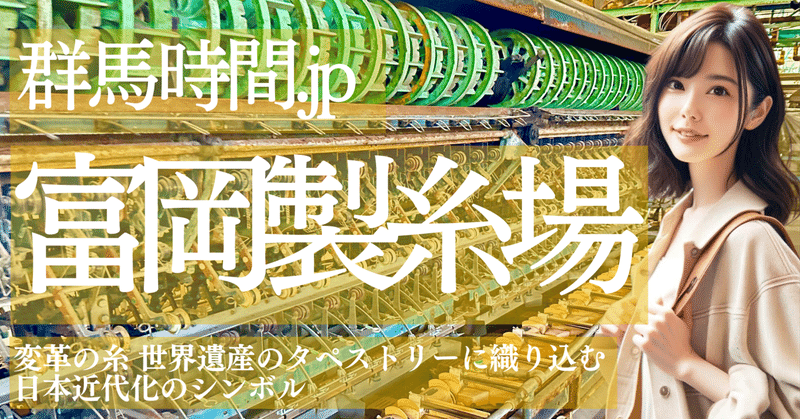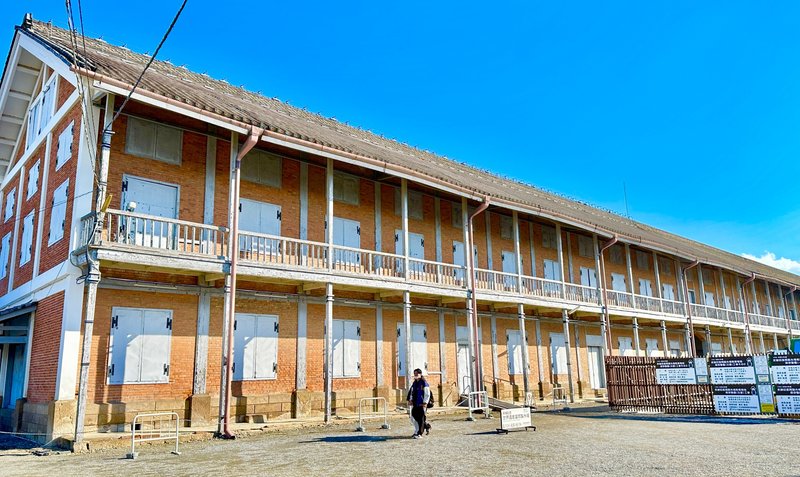
【群馬時間.jp】第1回 富岡製糸場:変革の糸 世界遺産のタペストリーに織り込む日本近代化のシンボル
富岡製糸場の創設背景とその意義
富岡製糸場の創設は、明治維新という日本の歴史上の転換点における、国家が直面した挑戦への対応の一例です。この時代、日本は国際社会において独立と尊厳を守り、経済的に自立するために、急速な近代化を遂げなければなりませんでした。その過程で、富岡製糸場は、日本が世界の絹市場において競争力を持つために不可欠な存在となりました。政府は、技術革新と産業の近代化を通じて、外貨を稼ぎ、国の富を増やす戦略を立案。生糸の輸出は、この戦略の中心的な役割を果たし、富岡製糸場はその生産基地として設立。この施設は、日本の工業化と経済発展の象徴となり、国際競争において日本が独自の地位を確立する一助となりました。


技術革新と国際協力の融合
富岡製糸場の成功は、西洋からの技術導入と、それを日本の地域的、文化的環境に適応させる能力によってもたらされました。フランス人技術者ポール・ブリュナの指導のもと、西洋の製糸技術が日本に持ち込まれ、それが国内での技術革新の契機となりました。このプロセスは、日本人の技術者や労働者に対する教育にも力を入れ、技術の継承と発展を促進。このような国際協力と技術移転の取り組みは、異なる文化間の交流が新たな技術革新を生み出す素晴らしい例を提供しています。また、この取り組みは、富岡製糸場が単なる製糸工場ではなく、日本の近代化を推進するための知識と技術のハブであったことを示しています。


女性労働者の革新的な役割
富岡製糸場のもう一つの特徴は、女性労働者の積極的な活用でした。この取り組みは、当時の日本社会における女性の地位と役割に対する新たな視点を提供。工場では、全国から集められた女性たちが先進的な製糸技術を学び、その後、地元コミュニティに帰ってその知識を広めることで、地域産業の発展に貢献しました。このように、富岡製糸場は女性の経済的自立と社会進出を促す重要な役割を果たし、女性が社会と経済の両面で重要な役割を果たすことができることを証明しました。

文化財としての富岡製糸場
富岡製糸場が世界遺産に登録されたことは、この施設が世界的に重要な文化的、歴史的価値を持つことの証明です。製糸業の発展だけでなく、産業革命期の日本の社会変革、技術革新、国際協力の歴史を今に伝える場所として、その価値は計り知れません。訪れる人々は、富岡製糸場を通じて、日本の近代化への道のりと、それを支えた人々の努力と知恵を学ぶことができます。



未来への教訓とインスピレーション
富岡製糸場は、過去の遺産を未来へとつなぐ架け橋の役割を果たしています。ここから学べる教訓は多岐にわたり、現代社会が直面するさまざまな課題に対しても、有効なヒントを提供しています。技術革新の精神、異文化間の協力の重要性、女性の社会参加の推進など、富岡製糸場が体現する価値は、今日の日本や世界社会が目指すべき姿を示しています。この歴史的遺産から得られる知識とインスピレーションは、より良い未来を築くための貴重な資源です。富岡製糸場の歴史は、過去を振り返りつつも、常に未来を見据えることの大切さを教えてくれます。

The Founding Background and Significance of the Tomioka Silk Mill
The establishment of the Tomioka Silk Mill is an example of Japan's response to the challenges faced by the nation at a turning point in its history, the Meiji Restoration. During this period, Japan had to undergo rapid modernization to maintain its independence and dignity in the international community and to become economically self-sufficient. In this process, the Tomioka Silk Mill became an essential entity for Japan to compete in the global silk market. The government devised a strategy to earn foreign currency and increase the nation's wealth through technological innovation and the modernization of industries. The export of raw silk played a central role in this strategy, and the Tomioka Silk Mill was established as its production base. This facility became a symbol of Japan's industrialization and economic development, helping the country establish its unique position in international competition.
Integration of Technological Innovation and International Cooperation
The success of the Tomioka Silk Mill was brought about by the introduction of Western technology and the ability to adapt it to Japan's regional and cultural environment. Under the guidance of the French technician Paul Brunat, Western silk-reeling technology was introduced to Japan, sparking domestic technological innovation. This process emphasized education for Japanese technicians and workers, promoting the inheritance and development of technology. Such efforts of international cooperation and technology transfer provide a great example of how exchanges between different cultures can generate new technological innovations. Moreover, these efforts demonstrate that the Tomioka Silk Mill was not just a silk-reeling factory but a hub of knowledge and technology to promote Japan's modernization.
The Innovative Role of Female Workers
Another characteristic of the Tomioka Silk Mill was its active utilization of female workers, offering a new perspective on the status and roles of women in Japanese society at the time. Women gathered from all over the country learned advanced silk-reeling techniques at the factory and then spread this knowledge in their local communities, contributing to the development of regional industries. Thus, the Tomioka Silk Mill played a significant role in promoting the economic independence and social advancement of women, proving that women could play important roles in both society and the economy.
The Tomioka Silk Mill as a Cultural Heritage
The registration of the Tomioka Silk Mill as a World Heritage site is proof of its globally significant cultural and historical value. Its importance lies not only in the development of the silk industry but also as a site that conveys the history of Japan's social transformation, technological innovation, and international cooperation during the Industrial Revolution. Visitors can learn about Japan's journey to modernization and the efforts and wisdom of those who supported it through the Tomioka Silk Mill.
Lessons and Inspiration for the Future
The Tomioka Silk Mill serves as a bridge connecting the heritage of the past to the future. The lessons learned here are diverse and offer effective hints for addressing various challenges faced by contemporary society. The spirit of technological innovation, the importance of cooperation between different cultures, and the promotion of women's participation in society are values embodied by the Tomioka Silk Mill that indicate the direction that modern Japan and the global community should aim for. The knowledge and inspiration derived from this historical heritage are valuable resources for building a better future. The history of the Tomioka Silk Mill teaches the importance of looking back at the past while always keeping an eye on the future.
この記事が気に入ったらサポートをしてみませんか?
